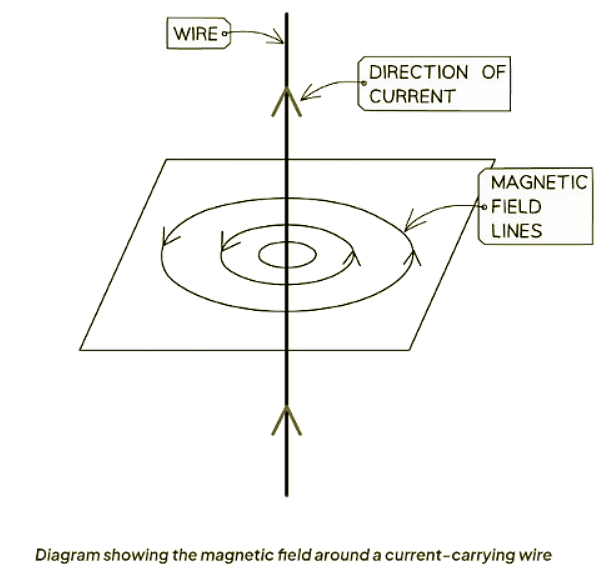Class 10 Exam > Class 10 Notes > Physics for GCSE/IGCSE > Magnetic Effect of a Current
Magnetic Effect of a Current | Physics for GCSE/IGCSE - Class 10 PDF Download
| Table of contents |

|
| Magnetic Field Around Wires & Solenoids |

|
| Magnetic Field Around a Solenoid |

|
| Magnetic Effects of Changing Current |

|
| Applications of the Magnetic Effect |

|
Magnetic Field Around Wires & Solenoids
- When an electric current traverses through a conducting wire, it generates a magnetic field surrounding the wire.
- Any wire through which current flows is considered a conducting wire in this context.
- To examine the configuration and orientation of the magnetic field, plotting compasses can be employed.
- These compasses illustrate the pattern of magnetic field lines, which typically resembles the following representation.
- The magnetic field consists of concentric circles encircling a current-carrying wire.
- The presence of a circular field pattern suggests that there are no distinct poles in the magnetic field surrounding the wire.
- As one moves away from the wire, the circles representing the magnetic field expand, indicating a decrease in field intensity.
- This observation illustrates that the magnetic field is most potent in proximity to the wire and diminishes as distance from the wire increases.
- The right-hand thumb rule offers a method to determine the direction of the magnetic field.
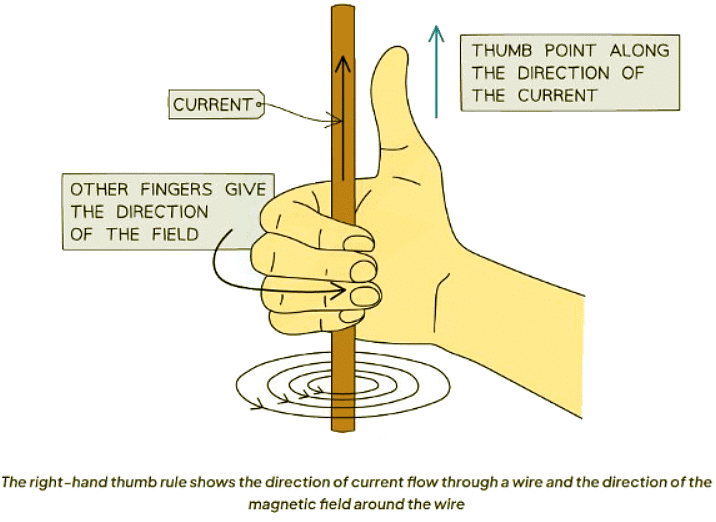
- Changing the direction of current flow in the wire will invert the orientation of the magnetic field.
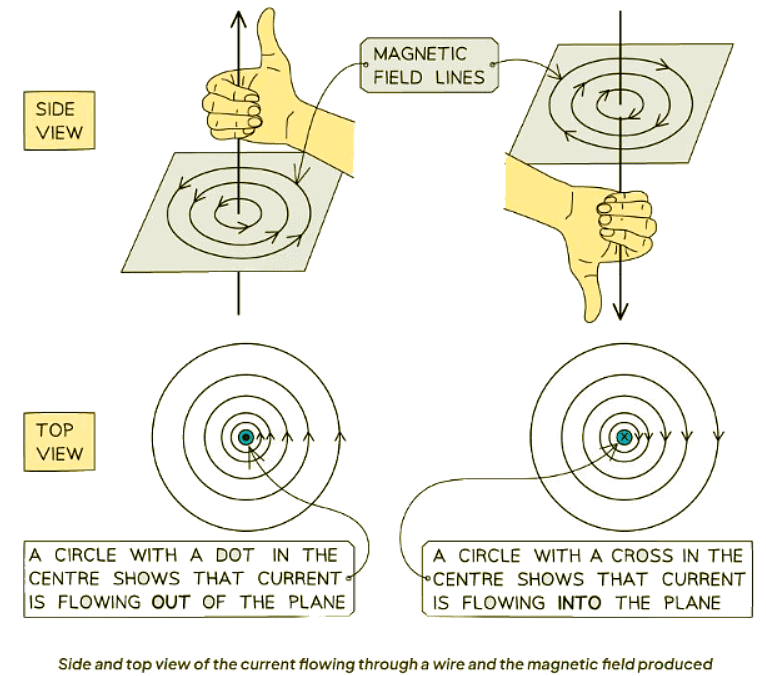
- Absence of current in the conductor results in the absence of a magnetic field.
- Enhancing the current passing through the wire amplifies the magnetic field's intensity.
- Consequently, this causes the magnetic field lines to converge, becoming closer to each other.
Question for Magnetic Effect of a CurrentTry yourself: What is the shape of the magnetic field surrounding a current-carrying wire?View Solution
Magnetic Field Around a Solenoid
- When a wire is coiled into a loop, magnetic field lines encircle each section of the coil, traversing through its center.
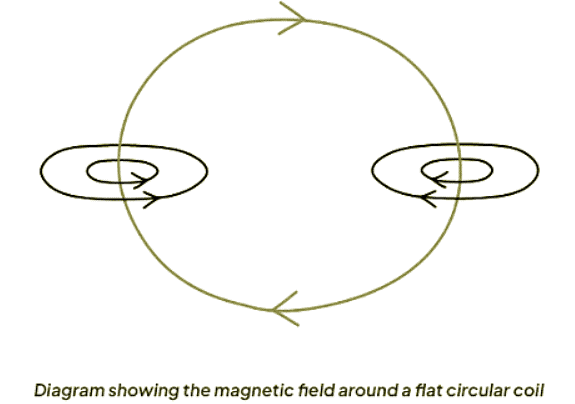
- To enhance the magnetic field's potency surrounding the wire, it should be wound into a solenoid configuration.
- The magnetic field encircling the solenoid closely resembles that of a bar magnet.

- The magnetic field within a solenoid is both powerful and consistent.
- Identifying the Poles:
- One end of the solenoid functions as the north pole, while the opposite end acts as the south pole.
- To determine the polarity of each end, observe the solenoid from the end.
- If the current flows clockwise, the end is the south pole; if anticlockwise, it is the north pole.
- Understanding Polarity:
- If the current changes direction, the north and south poles switch positions.
- In the absence of current, no magnetic field is generated around or through the solenoid.

Magnetic Effects of Changing Current
- By incorporating a soft iron core, a solenoid can function as an electromagnet.
- When electric current flows through the coils, the iron core becomes magnetized as an induced magnet.
- The combined magnetic field generated by the solenoid and the iron core significantly amplifies the overall magnet's strength.
- The electromagnet enables control over the magnetic field's activation, allowing it to be toggled on and off.
- A magnetic field surrounds the electromagnet when current flows through it.
- Conversely, when the current is deactivated, the electromagnet ceases to produce a magnetic field.
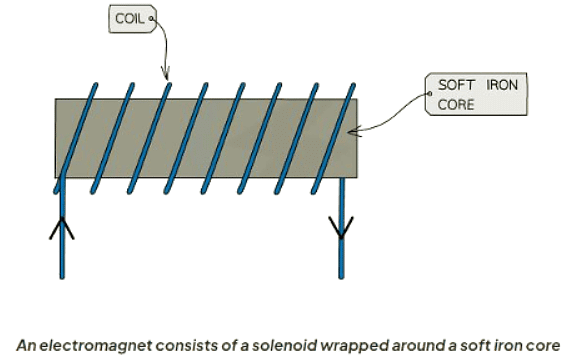
- Altering the current's direction also alters the magnetic field's orientation generated by the iron core.
Factors Influencing Magnetic Field Strength
- Augmenting the magnitude of the current flowing through the wire enhances the magnetic field strength surrounding the solenoid.
- Increasing the number of coils contributes to bolstering the magnetic field intensity.
- Introducing an iron core within the coils further strengthens the magnetic field produced by the solenoid.
- Adjusting the strength of an electromagnet is achievable by increasing or decreasing the current flow.
- Elevating the current amplifies the magnetic field surrounding the electromagnet.
- Conversely, reducing the current diminishes the magnetic field produced by the electromagnet.
Applications of the Magnetic Effect
- Electromagnets are utilized in various applications, such as relay circuits (found in electric bells, electronic locks, scrapyard cranes, etc.) and in loudspeakers & headphones.
Relay Circuits
- Relay circuits are commonly employed in electric bells, electronic locks, and scrapyard cranes.
Loudspeakers & Headphones
- Electromagnets play a crucial role in relay circuits where relays, acting as switches, are controlled by the electromagnet's action. A relay circuit typically consists of an electrical circuit containing an electromagnet and a second circuit with a switch located in proximity to the electromagnet in the first circuit.
- An electrical circuit consists of an electromagnet.
- Another circuit includes a switch positioned in close proximity to the electromagnet in the first circuit.

- When there is no current flowing through Circuit 1:
- The magnetic force ceases, causing the electromagnet to stop attracting the switch.
- The current in Circuit 2 also stops flowing.
- Circuit 1:
- The electromagnet stops attracting the switch.
- The current in Circuit 2 stops flowing.
- Circuit 2:
- Scrapyard cranes utilize relay circuits:
- When the electromagnet is activated, it attracts magnetic materials.
- When the electromagnet is deactivated, it releases the magnetic materials.
- Scrapyard cranes utilize relay circuits:
- Attract:
- When the electromagnet is switched on, it attracts magnetic materials.
- Drop:
- When the electromagnet is switched off, it releases the magnetic materials.
- Electric bells also use relay circuits:
- Animation: Electric bells utilize relay circuits. The alternating current causes the metal arm to strike the bell repeatedly, creating the ringing effect.
 Electric bells utilise relay circuits. As the current alternates, the metal arm strikes the bell and drops repeatedly to produce the ringing effect
Electric bells utilise relay circuits. As the current alternates, the metal arm strikes the bell and drops repeatedly to produce the ringing effect
Explanation
When the button K is pressed:
- A current passes through the electromagnet E, creating a magnetic field.
- This magnetic field attracts the iron armature A, prompting the hammer to strike the bell B.
- The armature's motion breaks the circuit at T.
- This interruption ceases the current, abolishing the magnetic field, causing the armature to revert to its original state.
- Restoring the circuit initiates the cycle once more.
Loudspeakers and Headphones
- Loudspeakers and headphones transform electrical signals into audible sound.
- They operate on the principle of the motor effect.
- A loudspeaker comprises a wire coil wound around one pole of a permanent magnet.
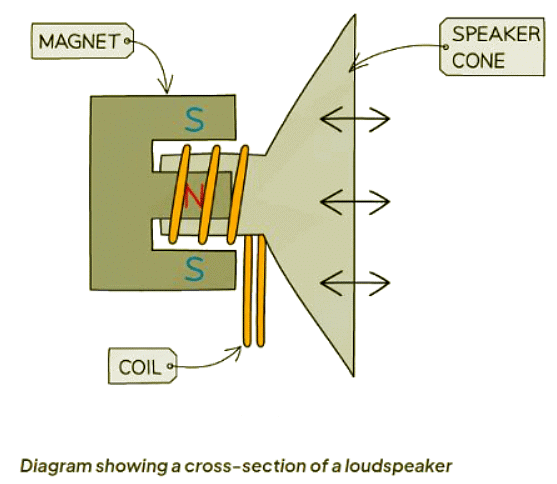
- An alternating current flows through the loudspeaker coil.
- This results in a fluctuating magnetic field encircling the coil.
- Because the current reverses direction continuously, the magnetic field's orientation also constantly changes.
- The magnetic field generated by the coil interacts with the permanent magnet's field.
- These interacting magnetic fields apply a force onto the coil.
- Fleming's left-hand rule aids in determining the force's direction at any given moment.
- With the magnetic field's constant change in direction, the force acting on the coil also shifts continuously.
- Consequently, the coil undergoes oscillation.
- This oscillation of the coil prompts the speaker cone to oscillate as well.
- As a result, the oscillating motion of the cone sets the air in motion, generating sound waves.
The document Magnetic Effect of a Current | Physics for GCSE/IGCSE - Class 10 is a part of the Class 10 Course Physics for GCSE/IGCSE.
All you need of Class 10 at this link: Class 10
|
126 videos|182 docs|35 tests
|
FAQs on Magnetic Effect of a Current - Physics for GCSE/IGCSE - Class 10
| 1. What is the magnetic field around a wire and how does it relate to the current flowing through the wire? |  |
Ans. The magnetic field around a wire is created by the flow of electric current through the wire. The direction of the magnetic field can be determined using the right-hand grip rule, where the thumb points in the direction of current flow and the curled fingers indicate the direction of the magnetic field.
| 2. How does the magnetic field around a solenoid differ from that around a straight wire? |  |
Ans. A solenoid is a coil of wire that produces a strong and uniform magnetic field inside its core when current flows through it. The magnetic field around a solenoid is concentrated within the coil, creating a more defined and powerful field compared to that around a straight wire.
| 3. How does changing the current in a wire affect the magnetic field around it? |  |
Ans. Changing the current in a wire results in a change in the magnetic field surrounding the wire. This phenomenon, known as the magnetic effect of changing current, induces an electromotive force (EMF) and generates a magnetic field that opposes the change in current flow, following Faraday's law of electromagnetic induction.
| 4. What are some practical applications of the magnetic effect of a current in everyday devices? |  |
Ans. The magnetic effect of a current is utilized in various devices such as electromagnets, transformers, electric motors, and generators. These applications demonstrate the conversion of electrical energy into mechanical energy and vice versa, playing a crucial role in modern technology.
| 5. How can the knowledge of magnetic fields around wires and solenoids be used to design and optimize electromagnetic devices? |  |
Ans. Understanding the behavior of magnetic fields around wires and solenoids allows engineers to design and optimize electromagnetic devices for specific purposes. By manipulating the direction and strength of magnetic fields, they can create efficient and reliable systems for various applications such as power generation, transportation, and communication.
Related Searches

